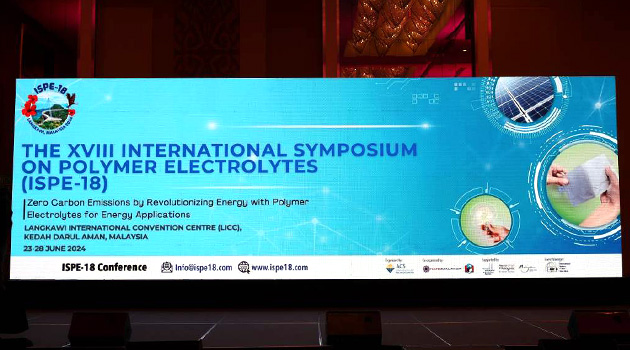
The ISPE (International Symposium on Polymer Electrolytes) conference, which began in 1987, is a highly prestigious conference in the field of polymer electrolytes held every two years. This conference focuses on organic, inorganic, and polymer materials related to the development of energy storage and conversion methods, specifically for use in batteries, supercapacitors, and fuel cells. This year's ISPE-18, held from June 23 to June 28, 2024, in Langkawi, Malaysia, the topic was ‘Zero Carbon Emissions by Revolutionizing Energy with Polymer Electrolytes for Energy Applications.
Lithium-ion batteries are a key industry driving carbon neutrality and are gaining attention as an alternative to fossil fuels. Electrolytes are crucial materials within batteries, enabling the movement of ions. In our research, to overcome the stability problems of conventional liquid electrolytes and improve the low electrochemical properties of polymer electrolytes, we were conducting research on composite polymer electrolytes. At this conference, I presented a poster on the topic 'Characterization and Electrochemical Properties of Composite Polymer Electrolytes with Electrospun Silica Nanofiber'. The polymer matrix used in our electrolyte research was Poly(ethylene carbonate) (PEC). This PEC was considered environmentally friendly as it utilizes CO2 in its synthesis process, contributing to CO2 reduction. Additionally, PEC can dissolve higher concentrations of metal salts compared to Poly(ethylene oxide) (PEO), which is commonly used in polymer electrolytes, and thus, it was expected to exhibit high electrochemical properties. Additionally, we used inorganic fillers as additives to prepare composite polymer electrolytes. By adding inorganic fillers, the crystallinity of the polymer chains was reduced, and due to the hydroxyl groups present on the surface of the inorganic fillers, we can expect an increase in metal ion mobility in the electrolytes. In this study, electrospun silica nanofibers were used as additives. The nanofibers, with their higher specific surface area compared to conventional particle type additives, were expected to increase interaction with polymer chains when used in composite polymer electrolytes. We presented the effect of the morphology of the fillers on electrochemical properties. As a result, it was found that silica nanofibers produced by electrospinning exhibited higher ionic conductivity compared to the previously used particle type silicon dioxide.

This international conference was specifically focused on polymer electrolytes used in energy storage. By attending other researchers' presentations, I can learn about the latest research trends in my field. It was also a valuable opportunity to gain useful knowledge that I can reference in my own research. Additionally, during my poster presentation, I received questions from other researchers, which helped me reconsider my research results from different perspectives and provided new ideas for further developing my research.
Lastly, I would like to express my deep gratitude to the ‘Marubun Research Promotion Foundation’ for providing financial support for participation in this international conference.
